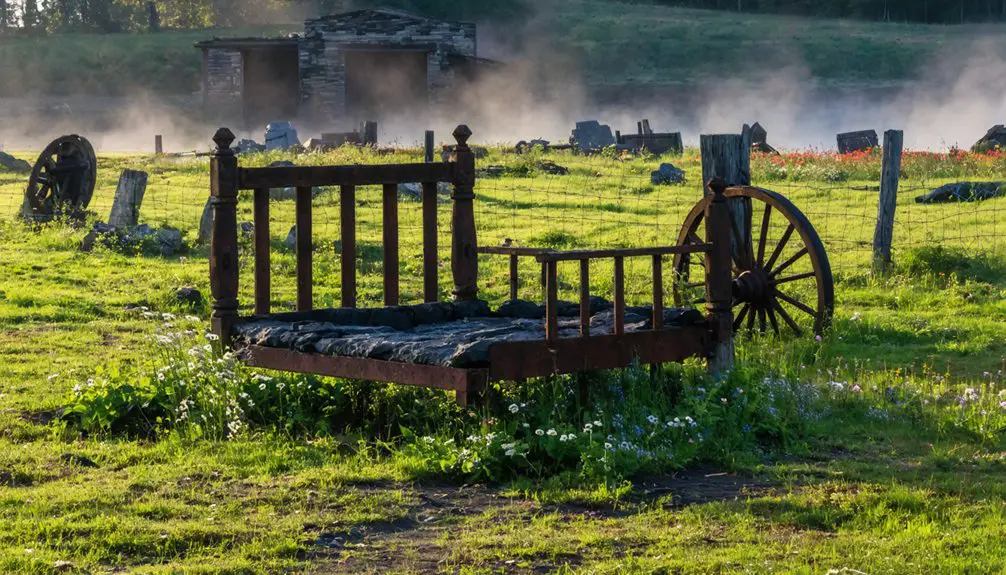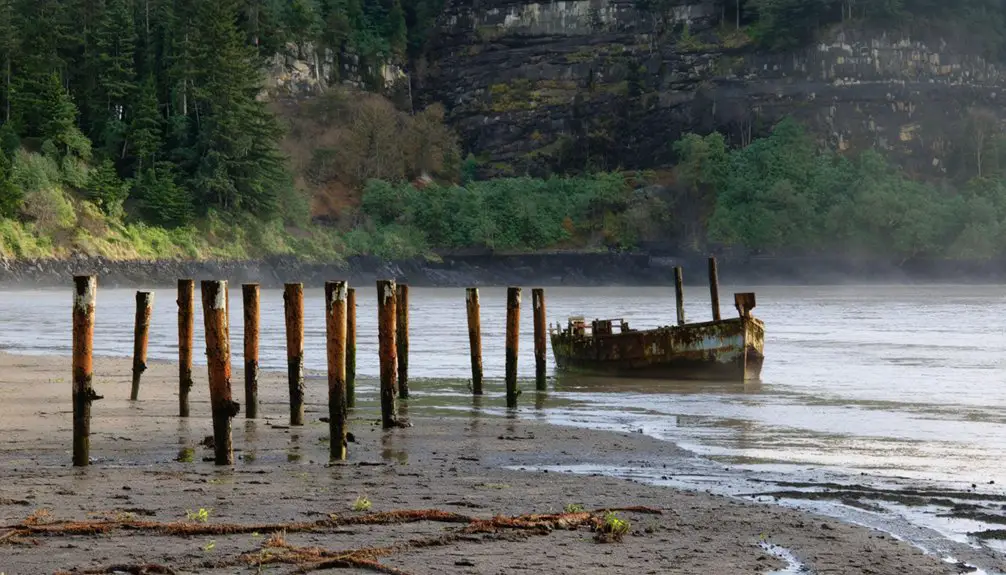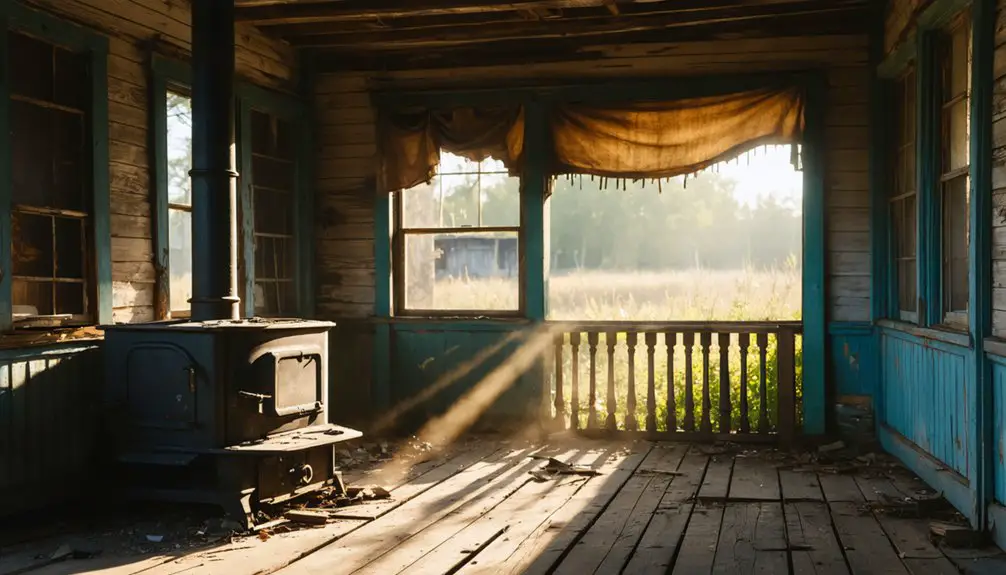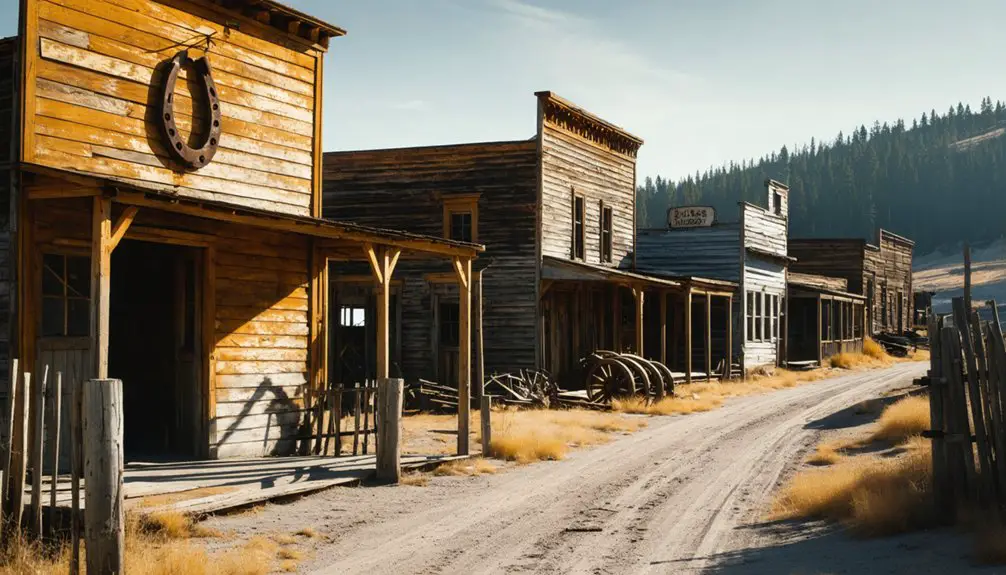You’ll find Yaquina City on Oregon’s central coast, where it emerged as a promising port settlement in 1863. The town flourished during the 1880s railroad boom, with Thomas Hogg’s ambitious Oregon Pacific Railroad project employing 2,000 workers. Despite early success, the settlement faced devastating setbacks including economic collapse, maritime challenges, and the catastrophic Great Fire of 1901. The site’s rich history spans from ancient Yaqo’n tribal settlements to its final days as a ghost town in 1958.
Key Takeaways
- Yaquina City transformed from a bustling railroad town to a ghost town after the Oregon Pacific Railroad’s financial collapse in 1890.
- The devastating Great Fire of 1901 destroyed 146 city blocks, accelerating the town’s decline and causing widespread abandonment.
- The town’s last official service, its post office, closed in 1958, marking the final end of Yaquina City as an active community.
- Failed railroad expansion plans and dangerous harbor conditions prevented Yaquina City from becoming a major port town.
- Historical preservation efforts have saved some original structures, while the town’s story lives on through local ghost stories.
The Birth of a Coastal Dream
Before European settlers dreamed of coastal development, the Yaquina Bay region thrived under the stewardship of the Yaqo’n tribe, who’d masterfully inhabited the area for over three millennia.
You’ll find their legacy woven into the landscape between Cape Foulweather and Beaver Creek, where they built strategic inland villages to shelter from storms while harvesting the bay’s abundant oysters and salmon.
Among their unique indigenous traditions, the Yaqo’n’s upper classes practiced cranial deformation to mark social status.
By 1863, this established way of life faced dramatic change when Captain Solomon Dodge founded the first of the coastal settlements, Oysterville. The settlement quickly became a hub for Winant & Company, which pioneered commercial oyster harvesting in the bay.
The tribe’s population suffered immensely as European diseases decimated their numbers by up to 80 percent.
You can trace the transformation as wagon roads soon connected the bay to the Willamette Valley, forever altering the delicate balance between the Yaqo’n’s 700-strong population and their ancestral lands.
Railway Promises and Early Prosperity
You’ll find that Hogg’s railroad dreams for Yaquina City began with tremendous promise, as the 1880s venture attracted wealthy investors and employed 2,000 workers with 250 horses to construct the narrow-gauge line connecting the coast to Corvallis.
The final completion milestone was marked when final spike was ceremoniously driven on December 31, 1884, though a severe snowstorm dampened the celebrations. The project faced immediate setbacks from the Depression of 1882, harsh weather conditions, and persistent financing troubles that plagued construction efforts. The Oregon Pacific Railroad was incorporated to secure funding for the ambitious development.
Despite briefly flourishing as a bustling railroad boomtown, Yaquina City’s prosperity proved short-lived when the rail line failed to extend to Newport, limiting its potential as a major transportation hub.
Railroad Dreams Fade Away
While railroad promoter Thomas Egenton Hogg envisioned a grand transcontinental link through Oregon, his ambitious plans for Yaquina City would ultimately fall short of expectations.
You can trace the collapse of his railroad ambitions through a series of setbacks: the loss of his crucial steamship Yaquina City in 1887, the dangerous harbor conditions that led to multiple shipwrecks, and the incomplete railway that never crossed the Cascades as promised.
The economic viability of the entire operation crumbled when the Oregon Pacific Railroad defaulted on its bonds in 1890.
After years of failed attempts to save the venture, Andrew B. Hammond purchased the railroad at sheriff’s auction for a mere $100,000 in 1894, ending Hogg’s dream of transforming Yaquina City into a major transportation hub.
Southern Pacific Railroad later acquired the line in 1907 for $750,000, showing the property’s increased value.
The rail line was quickly reorganized and renamed when Hammond established the Corvallis and Eastern Railroad in 1897.
Boom Years Turn Bust
As European settlers discovered the rich oyster beds of Yaquina Bay in the 1860s, a promising economic hub began taking shape along Oregon’s central coast.
The federal Indian agent collected fees from settlers seeking to harvest the abundant oysters, highlighting the early economic dynamics of the region.
You’d have witnessed Yaquina City’s rapid transformation into Lincoln County’s largest population center, with the economic implications rippling through the region as Colonel T. Egenton Hogg founded the town in 1882.
The area’s development came at a devastating cost to the Yaqo’n tribe, whose population had already been decimated by disease and displacement.
- A bustling community of 2,000 residents supported multiple sawmills, salmon canneries, and seven saloons.
- Schools, newspapers, and professional institutions showcased the town’s community resilience.
- The promise of becoming a transcontinental railroad terminus drove massive infrastructure investment.
But you can’t build an empire on dreams alone.
Poor investments, railroad construction mishaps, and steamship accidents gradually eroded confidence in Yaquina City’s commercial potential, marking the beginning of its decline from boom to bust.
Maritime Challenges at Yaquina Bay
The challenges haven’t gone unanswered.
You’ll see the results of extensive federal investment in jetties and dredging operations, while navigational technology has evolved from the historic lighthouse to modern Coast Guard warning systems.
Still, winter storms and spring tides continue to pose serious risks, requiring specialized bar crossing techniques and constant vigilance from vessel operators. The Coast Guard crews must master bar crossing techniques to safely navigate through the dangerous Yaquina Bay Bar. The treacherous conditions led to the tragic loss of the Yaquina City in 1887.
Native American Heritage and Displacement
For thousands of years before European settlement, Yaqo’n people thrived along Oregon’s central coast, establishing their homeland from Cape Foulweather to Beaver Creek.
You’ll find their cultural resilience reflected in practices like head flattening among the upper class and their strategic settlement patterns that balanced coastal access with inland protection.
Historical trauma began in 1855 when the U.S. government forced the Yaqo’n onto reservations, devastating their population from 700 to just 19 by 1900.
- Traditional hunting and gathering grounds spanning 400 acres between King and McCaffery Sloughs provided abundant marine and forest resources.
- The unsigned 1855 Coast Treaty left tribes without legal recognition or compensation for their lands.
- Despite displacement and disease, Yaqo’n descendants continue their legacy today within the Confederated Tribes of Siletz Indians.
The Great Fire of 1901

You’ll find evidence of the Great Fire of 1901‘s devastation in Yanquina’s charred ruins, where the blaze consumed 146 city blocks and left 10,000 residents homeless during its eight-hour rampage.
The inferno, which started near the Cleaveland Fibre Factory when sparks ignited Spanish moss during severe drought conditions, spread rapidly through the wooden structures of this southeastern Oregon community.
Though other Oregon towns rebuilt after similar disasters, Yanquina’s population scattered after the fire, and the town never recovered its former liveliness.
Fire’s Devastating Impact
During one catastrophic day in 1901, devastating flames engulfed Yanquina when sparks from a factory chimney ignited a pile of drying Spanish moss, leading to one of Oregon’s most destructive ghost town fires.
The fire’s rapid spread, fueled by dry wooden buildings and strong winds, overwhelmed the community’s fire safety measures. Within eight hours, the inferno destroyed 146 city blocks and over 2,300 buildings, leaving 10,000 residents homeless and causing $15 million in damage.
- The fire plume was visible hundreds of miles away, even reaching neighboring states
- Community resilience was tested as residents faced immediate needs for food, shelter, and economic recovery
- Martial law was declared to maintain order and prevent looting while government aid arrived
Recovery Never Materialized
While initial hopes remained high for rebuilding Yanquina after the devastating 1901 fire, the town’s recovery efforts quickly faltered under multiple challenges.
You’d have witnessed severe economic stagnation as reconstruction capital dried up and critical infrastructure remained in ruins. The once-bustling port and fishing industry couldn’t recover, while businesses failed to secure necessary loans and insurance.
Community fragmentation accelerated as residents scattered to other towns, severing long-held cultural bonds. The destroyed churches, schools, and meeting halls – traditional pillars of community life – were never rebuilt.
Environmental damage compounded these problems, with deforestation leading to soil erosion and reduced agricultural viability. Without proper transportation links or coordinated recovery planning, Yanquina became increasingly isolated, ultimately sealing its fate as a ghost town.
Transportation Networks and Economic Decline
As the Oregon Pacific Railroad established its terminus in Yaquina City during the 1880s, the town briefly flourished as an important transportation hub under Thomas Egenton Hogg’s ambitious vision.
You’ll find that transportation challenges soon emerged when Newport’s deeper ports proved more advantageous for maritime commerce. By 1937, the railroad’s abandonment sealed Yaquina’s fate, leading to economic isolation that you couldn’t overcome through alternative means.
- The town’s upstream location limited its ability to compete with Newport’s superior port facilities
- Loss of rail service crippled both passenger traffic and essential timber transport operations
- Shift to truck-based logging transport eliminated the need for local rail infrastructure
The inability to adapt to changing transportation needs ultimately transformed this once-promising hub into another Oregon ghost town, demonstrating how significant connectivity was to frontier survival.
Natural Geography and Port Limitations

Located between King and McCaffery Sloughs, Yaquina’s 400-acre peninsula offered a promising yet ultimately restrictive setting for maritime commerce. While you’d find rich oyster beds and abundant salmon in its waters, the bay’s geographic constraints proved challenging for large-scale port development.
The mix of saltwater and freshwater created an environmentally sensitive ecosystem that required careful management, limiting industrial expansion.
The harbor’s natural hazards, particularly near the original lighthouse site, made navigation treacherous. You’ll notice how shifting sandbars, persistent coastal winds, and ongoing sedimentation demanded constant dredging – a costly endeavor that hindered the port’s growth.
Despite early railroad connections and ambitions to rival Portland, the peninsula’s narrow footprint and surrounding protected waters simply couldn’t support extensive shipping infrastructure.
Life After the Boom Years
Once Yaquina City’s boom years ended in the mid-1890s, a series of catastrophic events sealed the town’s fate. A devastating fire in 1901 destroyed the business district, followed by the railroad’s abandonment in 1937 and Highway 101’s strategic bypass of the town.
Despite these setbacks, you’ll find examples of community resilience through various commercial revival attempts, most significantly Pete Rasmussen’s store in 1946, which later became the Mad Dog Tavern.
- The post office’s closure in 1958 marked the end of formal town services
- Local historical advocates saved several original structures from demolition
- The Yaquina Bay lighthouse earned historic landmark status in the 1970s
Today, you can explore this transformed landscape where conservation efforts blend with historical preservation, creating a unique reflection of the region’s past.
Legacy Among Oregon’s Lost Towns

The rise and fall of Yaquina City embodies a familiar pattern among Oregon’s lost towns, where ambitious dreams collided with harsh economic realities.
Oregon’s vanished coastal towns tell a story of grand visions meeting unforgiving truths, with Yaquina City standing as a poignant example.
You’ll find its cultural memory preserved in the haunting tales of Muriel’s ghost at the Yaquina Bay lighthouse and the stark reminders of what could have been – a “San Francisco of the North” that never materialized.
While the town’s physical presence has largely vanished, its legacy endures through preservation efforts at sites like the historic lighthouse and the West Yaquina Sitka spruce.
The ghost stories and maritime lore that surround these landmarks tell a deeper story of indigenous displacement, economic volatility, and the boom-and-bust cycles that shaped Oregon’s coastal development, making Yaquina City’s story a powerful cautionary tale of unfulfilled promise.
Frequently Asked Questions
Are There Any Remaining Original Buildings Still Standing in Yanquina Today?
You won’t find any original architecture in Yanquina today – the devastating 1901 fire destroyed all historic buildings, and despite preservation efforts elsewhere in Oregon, none of these structures survived.
What Happened to the Residents Who Lived in Yanquina After Its Decline?
Like birds seeking warmer winds, you’d find the residents scattered to nearby Toledo and Newport, driven by residential migration patterns and economic impact after the railroad’s closure and business district’s destruction.
Can Visitors Access the Ghost Town Site, and Where Exactly Is It?
You’ll find this ghost town site 4 miles east of Newport near Yaquina Bay (44°40’N, 124°02’W). It’s freely accessible, with historical railroad pilings and dock remains visible along public coastal trails.
Were There Any Notable Crimes or Legendary Stories From Yanquina’s Heyday?
You won’t find notorious incidents from Yanquina’s peak, except for a devastating 1901 fire. However, local legends tell of Muriel, a ghostly teen who haunts Yaquina Bay Lighthouse’s mysterious passages.
Did Any Famous Historical Figures Ever Visit or Live in Yanquina?
You won’t find many famous visitors in Yanquina’s history. While railroad promoter Thomas Egenton Hogg influenced its development and Joaquin Miller’s sister wrote about the lighthouse, neither actually lived there.
References
- https://www.yakonaoregon.org/history
- https://www.oregonencyclopedia.org/articles/yaquina-city/
- https://traveloregon.com/things-to-do/culture-history/historic-sites-oregon-trail/west-yaquina-sitka-spruce-heritage-tree/
- https://pinholeobscura.com/2015/10/28/the-ghost-of-the-yaquina-bay-light-oregon-coast/
- https://en.wikipedia.org/wiki/List_of_ghost_towns_in_Oregon
- https://www.oregonencyclopedia.org/articles/yaquina-bay-oyster-war/
- https://www.oregonhistoryproject.org/narratives/the-oregon-coastforists-and-green-verdent-launs/transforming-the-economy/acquiring-reservation-land/
- https://www.oregonhistoryproject.org/narratives/the-oregon-coastforists-and-green-verdent-launs/contact-and-settlement/resettlement-2/
- https://www.discovernewport.com/post/the-yaqo-n-the-first-people-of-newport
- https://pnwc-nrhs.org/Trainmaster2014/TM-2014-09.pdf



